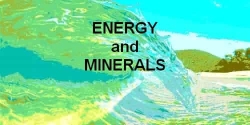Rock Identiification Basics
Rock Identiification Basics

Rock Origin
Rock Composition
Rock Texture
Geological Principals
Geological Time
Common Exploration Terms
see slso Igneous
rocks...
see also Sedimentary
rocks...
see also Metamorphic
rocks...
see
also Geological time...
see
also Absolute time...
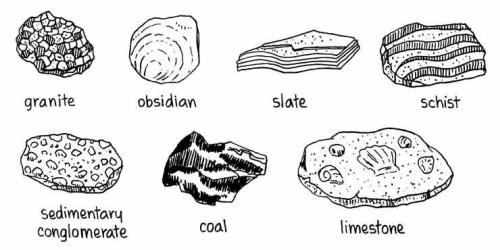
To identify
a rock, three things must be considered:
- origin,
- composition, and
- texture.
Rock Origin
The first step to identify a rock is to try to categorize the rock into one of the three main types or groups of rocks.These include igneous, sedimentary or metamorphic types.
The only rocks which do not fall into one of these categories are meteorites.
Igneous, sedimentary and metamorphic rock types are distinguished by the processes which form them.
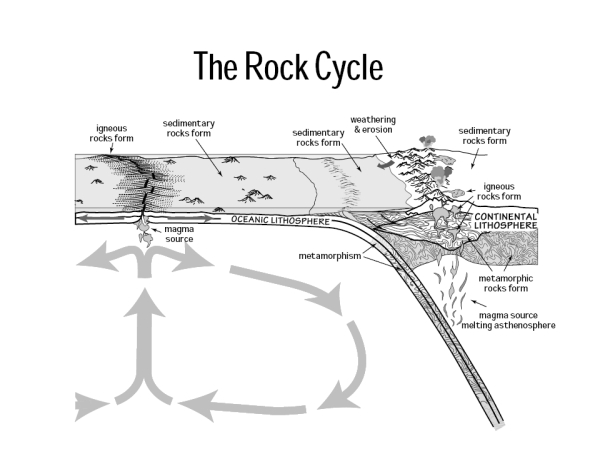
click here for a large very detailed version of the rock cycle from http://geologycafe.com/gems/chapter3.html
Igneous rocks:
form by crystallization of a melt (molten rock material).
Subcategories:
Plutonic:
formed at significant depth below the surface.

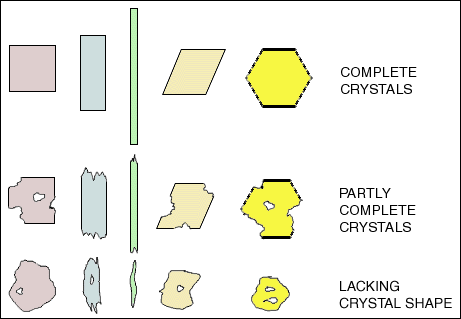
Volcanic:
formed at or near the surface.
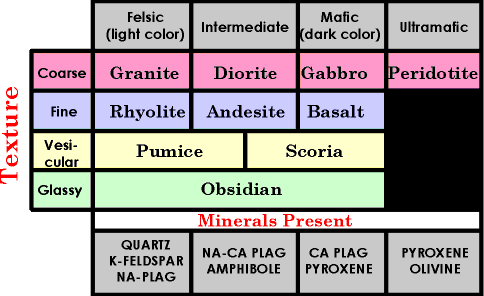
Sedimentary rocks:
form by the compaction small or large grains or fragments of pre-existing rocks, or by the precipitation of mineral matter from a body of water, such as an ocean, lake or stream.

Metamorphic rocks:
formed from pre-existing igneous, sedimentary or metamorphic rocks by subjecting them to heat and/or pressure and/or migrating fluids, causing the original mineral assemblage of the rock to change to a new assemblage of minerals. The origin is not always obvious, but sufficient training will enable recognition of certain features which point to the most likely origin. Examples include the common presence of bedding or layering in sedimentary rocks, and the presence of mineral foliations or lineations in metamorphic rocks. One must also consider the geologic environment where the rock is found.
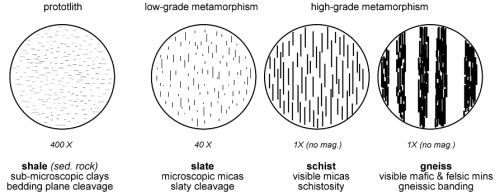
For example, in a young volcanic terrane one is less likely to find sedimentary or metamorphic rocks.
When the origin is completely unobvious, the composition and texture must be relied upon to make the best guess.
Download Identification of Common Rocks .pdf from this site...
Rock Composition
The rock composition is found by determining which minerals make up the rock.By definition, a rock is a solid mass or compound consisting of at least two minerals (although there are some exceptions when a rock may consist entirely of one mineral). The minerals comprising the rock can be identified using common field testing methods for individual minerals, particularly where the texture is sufficiently coarse-grained enough to distinguish the individual minerals with the naked eye or a hand lens.

Where the grain size of the minerals comprising the rock are too fine-grained to recognize discrete minerals, “petrographic” methods (those using a microscope) can be used for reliable identification in many cases.
Petrographic methods involve the use of a microscope to examine the optical properties of discrete minerals magnified through the microscope lens.
Properties include the behavior of refracted, reflected and transmitted light either through a thin wafer slice of the rock (called a thin section), or of a sample plug (for reflected light).
The light source is adjusted to provide light which polarized in one or two directions.

Different minerals have characteristic optical properties, which can be used with tables of optical mineral properties to identify the mineral.
Other instruments which can be used to make mineral identification include the electron microscope.
These methods are reliable but expensive, and require somewhat tedious sample preparation.
The image is obtained by exposing the sample to electron bombardment and imaging the results.
X-Ray Diffraction Techniques
Another method to identify small mineral grains is using X-ray powder diffraction.
A small amount of material is ground into a powder and bombarded with X-rays.
The results are recorded on a film strip in a camera, or in the form of graph.
The reflections of the X-rays are measured to determine the ‘d-spacings’ of the unknown mineral.
Each mineral has a unique set of peaks corresponding to d-spacings, which are related to the crystal structure.
In X-ray spectrometry, another method to identify minerals, the X-rays cause the emission of photons from the surface of the mineral.
The sample is prepared by obtaining a very high polish on its surface.
The photons emitted from the surface atoms have characteristic energies for specific elements.
By measuring the energy levels of the photons, the mineral composition can be identified.
Rock Texture
The texture of a rock is defined by observing two criteria:1) grain sizes,2) grain shapes.Grain Size:
the average size of the mineral grains.
The size scale used for sedimentary, igneous and metamorphic rocks are different
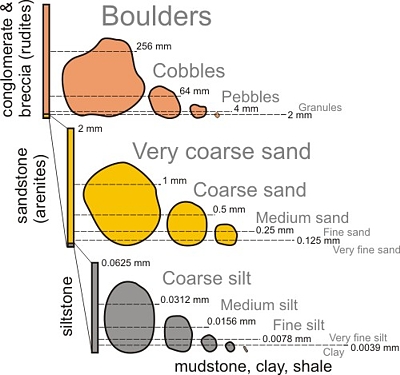
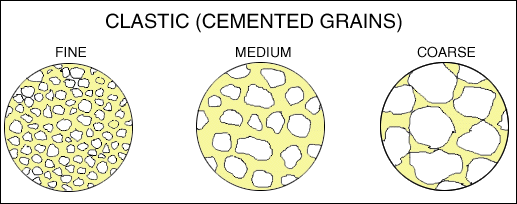

Grain Shape:
the general shape of the mineral grains (crystal faces evident, or crystals are rounded).
Examples of the size classifications for each of the three major rock types include:
FINE-GRAINED > > > > > > > > > > > > > > > > COARSE-GRAINED
Sedimentary: Shale Siltstone Sandstone Wacke Conglomerate
Metamorphic: Slate Phyllite Schist Gneiss
Igneous: Rhyolite Granite
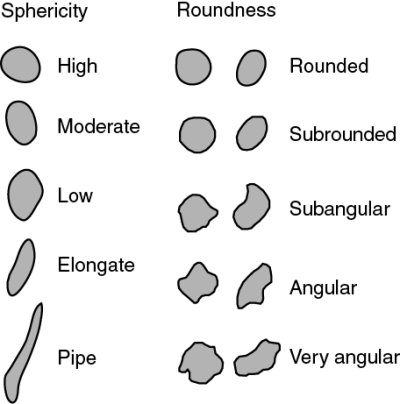
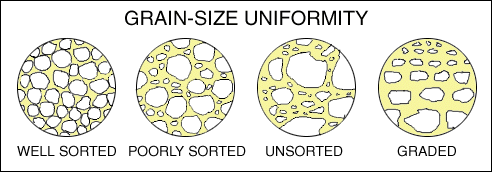
| Rock Type |
Very Fine Grained |
Fine Grained |
Medium Grained |
Coarse Grained |
Very Coarse Grained |
| Clastic Sedimentary |
.06 - .125 mm |
.125 - .25 mm |
.25 - .5 mm |
.5 1 mm |
1 2 mm |
| Metamorphic |
< .25 mm |
.25 1 mm |
1 2 mm |
> 2 mm |
|
| Igneous |
< 1 mm |
1 5 mm |
5 20 mm |
> 20 mm |
|
Sizes are median diameter of grains in millimeters.

Geologic Principles
One of the main goals of mineral exploration is to predict the geometry and relationships of different rock types under the surface where they can’t be seen either below the surface or beyond the immediate exposures.This is essential to know in order to plan a mine.
Much effort and a variety of techniques are used to analyze the timing or “geologic history” of the area
There are three main principles, or “laws”, which are used in field geological studies to guide in determining the relative timing of events.
Law of Cross-cutting Relationship
The “Law of Cross-cutting Relations” is a principle which is useful to employ in igneous provinces.
It states that invading rocks are younger than those invaded.
For example,
an igneous dike invading a sedimentary or metamorphic rock.
Another example is a situation where there are multiple intrusions are found; the sequence of igneous events can be sorted out by observing which intrusions cut which other intrusions.
The sequence might give an indication of a particular differentiation pattern of the magma.
The same law applies to veining relationships:younger veins cut across older vein sets
Often times where there are gold-bearing quartz veins there are also other veins which are barren, and may have a different orientation due to different structural conditions during formation.

Vein crosscutting relations.
Vein A is cut by Vein B.
Vein C cuts both A and B, so it is youngest.
Law of Superposition
The “Law of Superposition” is a law which applies to sedimentary rocks.
It states that where undisturbed, layered, sedimentary rocks occur, younger rocks will be situated on top (above) older rocks.
The same law can apply to layered volcanic flows, where the ages of the succeeding layers going up section will be relatively younger than the lower part of the section.
This law is also one which is employed to determine age relationships of different rock units.
In mineral exploration, a situation where this principle could be employed would be to project the underground geometry of a mineralized or petroleum enriched formation.
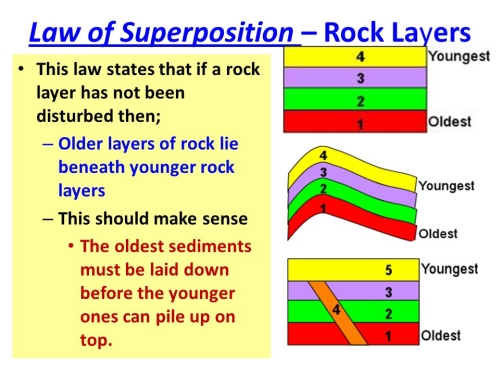
Principle of Uniformitarianism
The “Principle of Uniformitarianism” states that the earth is a result of natural forces which are presently active and have persisted over the course of geologic time.
Rocks form most often as a result of slow, gradual developments resulting from various geologic processes.
Catastrophic events do occur and contribute to the overall development and history of rocks, but these events are less frequent and contribute to only a small percentage of the net effect of natural forces in general.
This principle has been used to study the history of ancient volcanic rocks by observing present day volcanic activity.
For example, a certain type of massive sulfide deposit has been documented along an active sea floor rift.
This knowledge can be used to better understand a certain type of Copper-Lead-Zinc ore deposits, called “volcanogenic massive sulfide depsits”, or “VMS”.
Geologic Time
see also Some rocks exposed at the surface are very young, but most are very old, in fact are much older than the historical records of humanity.These “old” rocks are generally many millions of years in age.
The vastness of the concept of ‘millions” of years can be difficult to comprehend since human life times are so much shorter (generally less than 100 years).
Units of geologic time which have established include the “era” (longest), “period”, and “epoch” (shortest).
All of geologic time has been divided into 4 main eras, called (from oldest to youngest) the Precambrian, the Paleozoic, the Mesozoic and the Cenezoic.
Sites 1 6 provide illustrations and summaries of the geologic time scale. The earth has slowly changed throughout its history, and continues to do so as a result of a very slow cooling and differentiation process.
As a result, certain time periods during the earth’s history had conditions more conducive to formation of specific types of mineral deposits (Site 7).
For this reason, knowing the approximate age of rocks can be a rough guide to the types of mineral deposits most likely to be found. When evaluating the ages of rocks we speak of two types of terms of ages called “absolute age” and “relative age”.
“Absolute age” is measured in years, and depends on having some type of time scale to measure against, typically by using a highly technical chemical dating method.
“Relative age” simply means placing one geologic event or feature in context with another in a timing sequence.
Absolute Age:
During the early 1900’s, shortly after the discovery of radioactivity, it was discovered that radioactive decay involves the transformation of radioactive atoms into completely different elements.
Each radioactive substance disintegrates at its own rate and forms a unique set of daughter products (elements).
The rate of decay is generally very slow.
For example, uranium changes into lead at a rate such that half of the original amount will be converted to lead after a period of 4,500 million years.
Half of the remaining uranium will convert to lead in another 4,500 million years, and so on.
Therefore the “half life” of uranium is 4,500 million years.
By measuring the ratio of unchanged uranium to lead in a sample, and knowing the rate of decay, we can calculate the length of time the sample has been disintegrating, or in other words, the age of the rock.
Besides the Uranium-Lead method, several other radiometric techniques are available, including Carbon 14 and Rubidium-Strontium.
Relative Age Where different rocks are in physical contact and observable, the relative ages of the rocks can often be determined evaluating superposition and cross-cutting relationships.
Rocks comprising the upper strata are younger than rocks comprising the lower strata.
Rocks formed from an intruding magma are younger than the rocks they intrude.
Inclusions within an igneous rock are older than the magma which formed the matrix. When different rocks are in close proximity but their actual contacts are not visible, a geologic map and cross-section can be made which illustrate the geometric relationships of the rocks, and allows the determination of relative age. Difficulty is encountered when attempting to correlate rocks which are not in direct contact or even close proximity.
Fortunately geologists have worked out the evolutionary succession of fossil forms.
It was found that sedimentary rocks containing fossils could easily be placed in a successive sequence with respect to time by identifying the fossil assemblages present.
The natural outgrowth of this effort was to begin comparing rocks from all parts of the globe.
Fossils could now be used to attach relative ages to a wide variety of different sedimentary rock types.
They have been used to construct what is referred to as the “Geologic Time Scale”, which is a chronology of the earth’s history largely based on the fossil record. Since the oldest rocks and the oldest fossils are the ones most likely to become obliterated due to age, we have much more fossil data available for younger rocks, and hence these contain the smallest subdivisions of time.
The Paleozoic Era was when invertebrates and simple vertebrates (fish, amphibians and primitive reptiles) were the dominant life forms.
The Mesozoic Era was when reptiles, including the dinosaurs, ruled.
The Cenezoic Era is best characterized as the time when mammals became dominant.
Exploration Geology Terms
The following terms are useful to know: Ore:
the rock material or minerals which are mined for a profit.
Ore Minerals:
the specific minerals within the ore which contain the metals to be recovered.
Gangue Minerals:
the minerals having no commercial value, they just happen to be mixed up with the ore minerals.
Prospect:
potential ore deposit, based on preliminary exploration.
Mine:
Excavation for the extraction of mineral deposits, either at the surface (open pit mine) or below (underground mine).
Orebody or Ore Deposit:
naturally occurring materials from which a mineral or minerals of economic value can be recovered at a reasonable profit.
Mineral Deposit:
similar to an ore deposit, but is implied to be subeconomic or incompletely evaluated at present.
Mineral Occurrence:
anomalous concentration of minerals, but is uneconomic at present.
Grade:
this means the concentration of the substance of interest, usually stated in terms of weight per unit volume.
Cut-off Grade:
the lower limit of concentration acceptable for making a profit when mining.
Host Rock:
the rock lithology (type) which contains the ore.
May or may not comprise ore.
Country Rocks:
the rocks of no commercial value surrounding the host rocks and/or the ore.
Anomalous:
above or below the range of values considered to be normal.
source Delta Mine Training Centre
http://geologycafe.com/gems/chapter3.html

